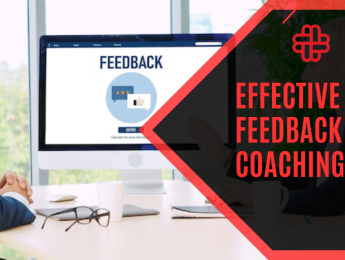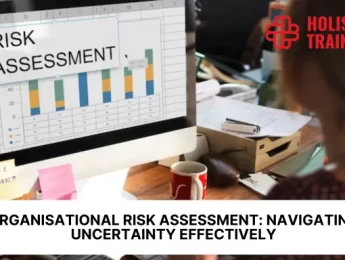The success of any organisation heavily relies on the collective performance and growth of its employees. As businesses strive to maximise their potential, the importance of performance coaching and effective feedback becomes increasingly evident. By nurturing a culture of continuous development and open communication, organisations can unlock the full potential of their workforce. In this comprehensive blog post, we will delve into the significance of performance coaching, explore essential questions for effective coaching, provide ten invaluable tips for feedback, and discuss methods to measure learning effectiveness post-training. Let's embark on this journey to enhance employee performance and drive organisational success.
What Is Performance Coaching?
Performance coaching is a dynamic process designed to enhance an employee's skills, competencies, and overall job performance. Unlike traditional performance evaluations that occur annually or semi-annually, coaching takes a more proactive and continuous approach to employee development. It fosters open communication, collaboration, and mutual understanding between managers and their team members. Performance coaching involves setting clear expectations, offering constructive feedback, identifying growth opportunities, and encouraging employees to take ownership of their professional development.
Questions to Consider When Coaching
As we delve into the realm of performance coaching, let us now explore the fundamental questions managers should consider when coaching their team members, setting the stage for personalised and effective growth strategies:
1. What Are the Employee's Career Goals and Aspirations?
Performance coaching should align with an employee's long-term career objectives. Managers must inquire about their team members' goals and aspirations, and then tailor coaching sessions accordingly. By understanding employees' aspirations, managers can provide targeted guidance to help them advance in their desired direction.
2. What Specific Skills Need Improvement?
Identifying the areas where an employee needs improvement is crucial for effective coaching. Conducting skill assessments and analysing performance data can help pinpoint the employee's strengths and areas for development. With this insight, managers can create personalised coaching plans.
Table 1: Employee's Career Goals and Aspirations
Question | Action |
What Are the Employee's Career Goals? | Inquire about long-term career objectives. |
How Can Coaching Align with These Goals? | Tailor coaching sessions to align with aspirations. |
What Resources or Opportunities Are Needed? | Identify resources and opportunities for development. |
Table 2: Identifying Specific Skills for Improvement
Question | Action |
Which Skills Need Improvement? | Identify areas requiring development. |
How Will Improvement Be Measured? | Establish metrics to track skill enhancement. |
What Are the Preferred Learning Methods? | Adapt coaching methods to individual styles. |
3. How Can I Tailor Coaching to Individual Learning Styles?
Every employee has a unique learning style, so managers must adapt their coaching methods to suit each individual. Some employees may prefer hands-on training, while others might benefit from written materials or visual aids. Flexibility in coaching approaches ensures maximum learning effectiveness.
4. Are There Any External Factors Affecting Performance?
Consider external factors that could impact an employee's performance. Personal or work-related challenges may hinder their progress. As a manager, demonstrate empathy and support to address these issues and create a conducive work environment.
10 Tips for Effective Feedback and Coaching
Now, armed with essential insights into the significance of performance coaching and the questions to consider, let's proceed to unveil ten invaluable tips for providing effective feedback and coaching, nurturing a culture of continuous improvement and success:
1. Establish a Positive and Supportive Environment
Creating a positive and supportive atmosphere is the foundation of successful coaching. When employees feel comfortable and respected, they are more likely to open up about their challenges and aspirations. Managers should foster an environment where individuals can express themselves freely, without fear of criticism or judgement. This sense of psychological safety empowers employees to take risks, innovate, and embrace continuous learning.
2. Set Clear Goals and Expectations
Clarity is crucial in the coaching process. Employees must have a clear understanding of what is expected of them, both in terms of their current responsibilities and their future development. Managers should set specific, measurable, achievable, relevant, and time-bound (SMART) goals with their team members. SMART goals provide a roadmap for employees to track their progress and serve as a basis for ongoing feedback and evaluation.
3. Focus on Strengths and Development Areas
Effective coaching encompasses both acknowledging an employee's strengths and addressing areas that require improvement. Recognising and appreciating an employee's strengths boost their confidence and motivation. Conversely, addressing development areas with empathy and constructive feedback encourages individuals to work on enhancing their skills and competencies.
4. Use the SBI Model for Feedback
The Situation-Behavior-Impact or SBI model is a powerful tool for delivering feedback in a clear and actionable manner. Managers should describe the specific situation where the observed behaviour occurred, detail the behaviour itself, and then explain the impact it had on the team, project, or organisation. This model helps employees understand the context of the feedback and facilitates meaningful discussions on performance improvement.
5. Encourage Self-Reflection
Coaching is not solely about top-down guidance; it should also empower employees to reflect on their own performance. Encouraging self-reflection allows individuals to identify their strengths and areas for growth independently. By engaging in self-assessment, employees become more proactive in seeking feedback and finding solutions to their challenges, thereby fostering a sense of ownership over their development.
6. Provide Timely and Regular Feedback
Feedback loses its effectiveness when delivered too late. Timeliness is critical to ensure that feedback is relevant and applicable to the employee's recent actions. Regular coaching sessions should be scheduled to maintain an ongoing dialogue between managers and employees. This approach facilitates continuous improvement and prevents minor issues from escalating into more significant challenges.
7. Use the "Sandwich" Technique with Caution
The "sandwich" technique, where constructive feedback is "sandwiched" between two positive points, has been widely used in the past. However, managers should exercise caution with this approach, as it may dilute the impact of critical feedback. Instead, focus on providing genuine, well-articulated feedback, ensuring that both praise and areas for improvement are communicated thoughtfully and separately when necessary.
8. Focus on Actionable Solutions
Coaching should never end with identifying areas for improvement. Collaborate with employees to develop actionable solutions to address their developmental needs. By involving employees in devising their own improvement plans, managers instil a sense of empowerment and accountability. These actionable solutions can take the form of workshops, training programmes, mentorship opportunities, or cross-functional projects tailored to the employee's growth trajectory.
9. Provide Opportunities for Skill Development
Investing in skill development demonstrates an organisation's commitment to employee growth and success. Managers should identify relevant training programmes, seminars, workshops, and certifications that align with the employee's aspirations and job responsibilities. Skill development not only enhances individual competencies but also contributes to the overall organisational performance and adaptability.
10. Follow Up and Track Progress
Coaching is a continuous process that extends beyond a single session. Managers should consistently follow up with their team members to monitor progress, offer ongoing support, and celebrate milestones. Tracking progress allows for timely adjustments to coaching strategies and ensures that employees remain on track to achieve their goals.
Effective feedback and coaching are cornerstones of a high-performance culture. By implementing these ten tips and creating a nurturing environment for your employees, you can enhance their development, drive productivity, and propel your organisation toward lasting success. Remember, it's a journey of continuous improvement, and the results will be well worth the effort.
How to Measure Learning Effectiveness
Measuring the effectiveness of learning initiatives is a critical aspect of evaluating the impact of coaching and training on employee performance and overall organisational success. By determining the effectiveness of these initiatives, organisations can make informed decisions about their training programmes, identify areas for improvement, and allocate resources more efficiently. Here are some key methods to measure learning effectiveness:
1. Skill Assessments
Pre- and post-training skill assessments provide valuable insights into an employee's knowledge, competencies, and capabilities. These assessments can be conducted using quizzes, tests, or practical evaluations. By comparing the results before and after the training, managers can gauge the level of improvement and identify areas that still require development.
2. Performance Metrics
Performance metrics are essential indicators of learning effectiveness. Analysing key performance metrics, such as productivity, efficiency, quality of work, and customer satisfaction, can provide a tangible measure of how well employees have applied their newly acquired skills in their roles. Positive changes in these metrics can indicate the effectiveness of the coaching and training.
3. Surveys and Feedback
Gathering feedback from employees through surveys and questionnaires can offer valuable qualitative data. Employees' perceptions of the training content, delivery, and its applicability to their roles provide valuable insights into learning effectiveness. Surveys can also capture the impact of training on employee motivation, engagement, and confidence.
4. 360-Degree Feedback
Involving peers, managers, and subordinates in providing feedback on an employee's performance after training is a comprehensive approach. This multi-perspective feedback provides a more holistic view of the employee's growth and development, giving a better understanding of the training's impact on various aspects of their performance.
5. Observations and Case Studies
Observing employees in real work scenarios to assess how they apply newly acquired skills in practical situations is a powerful method to measure learning effectiveness. Additionally, conducting case studies or simulations that simulate workplace challenges can demonstrate the application of training concepts in a controlled environment.
6. Learning Management Systems (LMS)
Utilising Learning Management Systems like TalentLMS can simplify the process of measuring learning effectiveness. LMS platforms offer robust tracking and reporting features that capture various data points, such as completion rates, assessment scores, and user engagement. This data aids in evaluating the overall success of the training initiatives.
7. Post-Training Evaluations
Conducting post-training evaluations provides an opportunity for employees to reflect on their learning experience and assess how well the training has addressed their developmental needs. These evaluations can help identify any gaps in the training content or delivery and enable improvements in future training programmes.
8. On-The-Job Application
A powerful indicator of learning effectiveness is the extent to which employees apply newly acquired skills and knowledge to their daily work. Encourage employees to share their experiences and success stories of using the training content in their roles.
Employee Engagement and Its Link to Performance
Employee engagement is a critical factor in driving overall organisational performance. When employees are engaged, they are not just satisfied with their jobs but also deeply connected to their work, their colleagues, and the organisation's mission. Here are several key points highlighting the importance of employee engagement:
Increased Productivity
Engaged employees tend to be more productive. They are motivated to go the extra mile in their tasks, leading to improved output and efficiency.
Higher Quality of Work
Employees who are engaged take more pride in their work. They are more likely to pay attention to detail, resulting in higher quality work and fewer errors.
Better Customer Satisfaction
Engaged employees often provide better customer service. Their enthusiasm and commitment to the organisation's goals reflect positively on customer interactions, leading to increased customer satisfaction and loyalty.
Lower Absenteeism and Turnover
Engaged employees are more likely to stay with their organisation. They have a sense of commitment and loyalty, reducing turnover rates and associated recruitment costs.
Innovation and Problem-Solving
Engaged employees are more likely to contribute ideas and solutions. They feel a sense of ownership and are more willing to share their insights, driving innovation and problem-solving within the organisation.
Positive Workplace Culture
Employee engagement contributes to a positive workplace culture. When employees are engaged, the atmosphere becomes more collaborative, supportive, and conducive to growth and development.
Enhanced Employee Health and Well-being
Engaged employees often experience lower stress levels and better overall well-being. This can result in reduced healthcare costs and a more positive work environment.
In summary, fostering employee engagement is not just a means to improve job satisfaction; it's a strategic move that can significantly impact an organisation's performance, culture, and bottom line. Managers should prioritise engagement initiatives to unlock the full potential of their workforce.
The Power of Mentorship
In addition to coaching from managers, mentorship programmes can significantly contribute to employee growth. Pairing employees with experienced mentors allows for personalised guidance and knowledge transfer. Mentorship fosters a sense of belonging, accelerates learning, and helps employees navigate their career paths more effectively. Here are several key points highlighting the importance of mentorship:
Knowledge Transfer
Seasoned employees can pass on their knowledge, skills, and insights to less-experienced colleagues. This transfer of expertise helps bridge skill gaps and accelerates learning.
Personalised Guidance
Mentorship offers personalised guidance tailored to the mentee's needs and goals. Mentors can provide one-on-one support, helping individuals navigate their career paths more effectively.
Career Advancement
Mentors often provide valuable advice on career development and advancement opportunities. This guidance can be instrumental in helping mentees make informed decisions about their professional trajectories.
Increased Confidence
Mentees often gain confidence in their abilities through mentorship. The encouragement and positive reinforcement from a mentor can empower individuals to take on new challenges and responsibilities.
Networking Opportunities
Mentors can introduce mentees to valuable contacts within and outside the organisation, expanding their professional network and opening doors to new opportunities.
Enhanced Problem-Solving
Mentors can share their experiences and offer insights into problem-solving strategies. This can help mentees tackle challenges more effectively and make informed decisions.
Retention and Engagement
Organisations with mentorship programmes often experience higher levels of employee retention and engagement. The sense of support and guidance provided by mentors can lead to greater job satisfaction and loyalty.
Leveraging Technological Tools for Performance Management
In today's digital age, technology plays a pivotal role in enhancing performance management processes. Utilising technological tools can streamline various aspects of performance management, making it more efficient, data-driven, and adaptable to the needs of modern organisations. Here are key points highlighting the significance of leveraging technology for performance management:
Data-Driven Insights
Performance management software and tools allow organisations to collect and analyse data related to employee performance. This data-driven approach enables organisations to make informed decisions, identify trends, and address issues proactively.
Efficient Goal Setting and Tracking
Technology facilitates the creation and tracking of performance goals and objectives. Managers can set SMART (Specific, Measurable, Achievable, Relevant, Time-bound) goals, monitor progress, and provide timely feedback using digital platforms.
Real-Time Feedback
Digital tools enable real-time feedback mechanisms, ensuring that feedback is delivered promptly. This immediate feedback loop can help employees address issues promptly, leading to faster skill development and performance improvement.
360-Degree Feedback
Many performance management systems support 360-degree feedback, allowing input from peers, subordinates, and managers. This holistic approach provides a comprehensive view of an employee's performance, fostering a more accurate assessment.
Enhanced Employee Development
Technology allows for the creation of personalised development plans. These plans can include access to e-learning resources, training modules, and skill-building opportunities that align with individual career aspirations.
Automated Performance Reviews
Performance management tools often automate the performance review process. This reduces administrative burden, ensures consistency in evaluations, and frees up time for more meaningful discussions.
Continuous Performance Monitoring
Continuous performance monitoring tools provide ongoing visibility into employee performance. Managers can track progress, identify areas for improvement, and intervene as needed, promoting a proactive approach to performance management.
Data Security and Compliance
Performance management software often includes robust security features to protect sensitive employee data. Additionally, these tools help organisations maintain compliance with data protection regulations.
Integration with HR Systems
Many performance management tools integrate seamlessly with other HR systems, such as payroll and talent management platforms. This integration streamlines HR processes and ensures data accuracy.
Enhanced Employee Engagement
Interactive digital platforms can engage employees more effectively. Gamification elements, social recognition features, and interactive dashboards make performance management more engaging for employees.
In summary, leveraging technological tools for performance management empowers organisations to adapt to the changing demands of the modern workforce. These tools not only streamline administrative processes but also enable data-driven decision-making, fostering a culture of continuous improvement and innovation within the organisation. Embracing technology in performance management is not just a trend; it's a strategic move to enhance employee development and organisational success.
Conclusion
Managing employee performance through effective feedback and coaching is an indispensable aspect of fostering a thriving and engaged workforce. By embracing performance coaching, managers can unlock the full potential of their employees, driving productivity, and propelling organisational success. The key lies in understanding each employee's unique needs, providing constructive guidance, and maintaining an environment that encourages continuous growth and learning.
Remember, effective coaching is a journey, not a one-time event. As managers invest time and effort in nurturing their employees' development, they build a workforce that not only achieves success but also becomes a driving force for innovation and progress. By implementing the tips provided in this blog post and leveraging resources to measure learning effectiveness, organisations can cultivate a culture of excellence that will flourish and thrive well into the future.

























